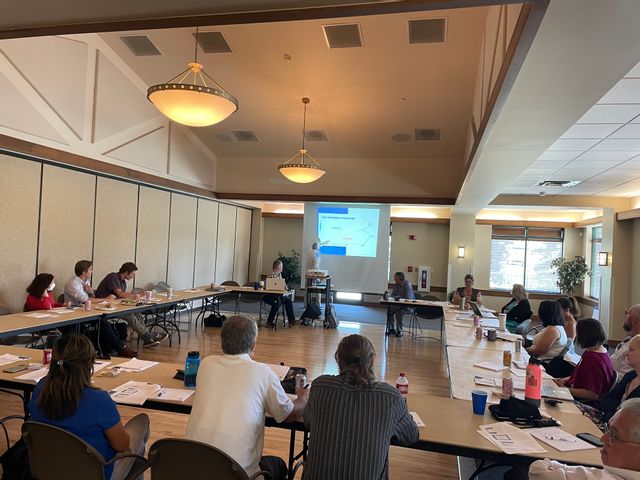TAX INCREMENT FINANCE 201 | Maximizing impacts of Tax Increment Financing
BACKGROUND
Downtown Colorado, Inc., (DCI) is Colorado’s home for training, best practices, and networking for Tax Increment Finance (TIF) and building knowledge around Downtown Development Authorities (DDAs) and Urban Renewal Authorities (URAs) in Colorado. We recently held a Tax Increment Finance 201 session in Wheat Ridge and are pleased to share the summary from the event.PURPOSE
Expand the understanding around how we use tax increment finance (TIF) to make development happen that fits your community vision, and identify the approaches to partnerships for leveraging TIF by urban renewal authorities + downtown development authorities.PARTICIPANTS

BIGGEST FEARS

As a part of the introductions, all participants shared their community, the formation date of the authority, and the formation date of the plan area. They also shared the thing they are most afraid of, and the responses included:
+ Moratorium on Redevelopment
+ Having a Less Knowledgeable Assessor
+ Community Push Back to Term “Blight”
+ Lack of Money Equalling Lack of Progress
+ Having so many plan areas that management gets challenged
+ Misinformation + Miscommunication about how TIF Works
+ Anti-Redevelopment Initiatives
+ Expanding the Board with HB 1348
+ Failed Expectations
+ Legal Requirements and Cost of Complying with 1348 for Smaller Rural Communities
+ Tax Day
+ Ice Breaker Questions
+ Public Speaking
+ Spiders
SO, YOU FORMED A TAX INCREMENT FINANCE PLAN AREA - WHAT NEXT?
The group discussed important items to consider when forming your TIF Plan area to lay the groundwork for a successful plan, including collaboration, consideration, and partnerships. Using a Conditions Study/Impact Study, and other due diligence to shape your plan area AND to connect to a future use, possibly developers, and what the vision is for the future. The process must include active collaboration with the leadership, other taxing entities, the public and private sector investors.
When forming a plan, there is always a chance that the expectations will not be met, so having a catalyst development in mind - both the place, the use, and the community’s vision for co-investment - will help to ensure that the development moves forward and generates the TIF as planned. It is important to balance the projections so that commercial development, as a larger revenue source, may help support affordable housing or other community goals. It is also important to consider the vision and engagement of the community. Making sure that the community is both familiar and supportive of projects and future uses lays the groundwork for a successful development.
A key idea is that identifying the “perfect plan area” has changed over time. The goal is to have a narrowly defined area for TIF so that the increment can be collected and reinvested without losing “decrement” or negative increment, which could happen when something is demolished, purchased by a public entity, etc. It is also of note, that each area will also have administrative costs and so the number of plan areas can also add to administrative costs. With the addition of HB15-1348, legislation that impacted the composition of a URA board and TIF negotiation, there was an effort to develop plan areas that would not require significant modification. So there has been a balancing act to draw a plan as narrowly as possible while establishing a plan that will stand up for more than twenty-five years.
It is important to note that DDAs have a Plan of Development, and while they negotiate TIF agreements, they don’t have as many intricacies as URAs TIF Plan Area.
A TALE OF TWO ACTIVITIES - UNDERSTANDING TIF AGREEMENTS BY SCALE
When considering agreements, the value proposition is what we use to balance the risk for public-private partnerships. The lowest risk approach for a DDA or URA is going to be a Developer issuing bonds in partnership with a Metro District , or having an agreement to reimburse the Developer ONLY with the TIF generated by their project. The higher risk approach is for the URA or City to issue bonds and repay the bonds with TIF. The middle ground is the Developer using the TIF Reimbursement as part of the pro-forma and taking that to the bank to get a loan. If the project is a high priority, the URA might be ready to take a larger risk. If the project is a good one but not a priority, maybe the URA will pledge the TIF as reimbursement based on the increment that this project is able to produce.
The conversation reviewed two scenarios which require different approaches to leveraging TIF. There is an important need to understand and communicate clear roles for the community, the URA and theDeveloper, and to dive into the timing and how TIF will be applied. The two scenarios considered, with examples of a deal with TIF to fill the gap, include:
1. Large Projects with bonding potential and working with Metro Districts or other financing; and
2. Small urban infill activities that are too small to bond, which might apply TIF as revenue to proformas to help private sector get financing.
AGREEMENTS WITH OTHER TAXING ENTITIES
The process is going to begin with developing a relationship and understanding with the Assessor to ensure they are informed of improvements and also that you are clear on how they do their assessment, their timing, etc. This relationship and building a transparent exchange of information will assist in clear expectations for what comes next.
Whether a DDA or URA, it is important to maintain good relationships with the other taxing entities, especially the County, School District, and the Special Districts. These entities will eventually benefit from the investment and growth of increment in the area so understanding the process for creating increment is important to communicate early.
DEVELOPER AGREEMENTS
The Developer Agreement outlines the expectations of both the DDA or URA and the Developer. This should be based on a project proforma that demonstrates the gap - or the additional costs the project will incur that are beyond what the market will bear.
Agreements can be focused on a specific time frame, project, or purpose. Agreements can be based on an individual property - so the developer buys a property, and only the portion of the increased property value of that property is used to reimburse the developer.
BASIC TOPICS FOR AGREEMENT
Some of the items that are often looked at in agreements are included in the below list, there are also intermediate and advanced topic lists that DCI will provide in a more in depth document in our online resource library.
+ Deposit. Deposit may cover costs of negotiation and damages if the developer terminates. Deposits may also be reimbursed when increment is accrued.
+ Accountability. Outlines what the developer has to do and when to demonstrate that she is moving forward with the project.
+ Assignability. The DDA or URA may wish to restrict the right of a Developer to assign its rights and obligations under the Development Agreement to other entities without the consent of the DDA or URA, or to transfer to another person any asset such as real property or a valuable right such as a contract or promissory note.
+ Eligible Improvements. Review the improvements that are considered “eligible improvements” for which TIF may be used/allocated.
+ Guardrails. are a tool to ensure alignment with the organization's goals and objectives and to keep people on the right path.. The power of guardrails lies in the fact that they shape decisions by defining boundaries as to the terms and conditions of reimbursements
MORE ADVANCED TOPICS
+ Chicken and Egg. The DDA or URA and the Developer must negotiate who commits dollars first. Typically private funds follow public commitments to provide funds.
+ Sharing in the Upside. The DDA or URA and the Developer may negotiate various ways in which the public body can share in the upside of development in addition to the increase in property tax base and sales tax revenue.
+ Transparency. Developers may have concerns about sharing confidential information with public bodies, which may become subject to open records requests. Solutions include agreements that the information shall remain confidential, or sharing the information with a third party that can provide an analysis of the information to the DDA or URA.
In addition to the (believe it or not) brief summary above, the following list of questions and answers were developed during the TIF 201. DCI is honored to work with our esteemed speakers and the broad range of participants who made the event possible!




